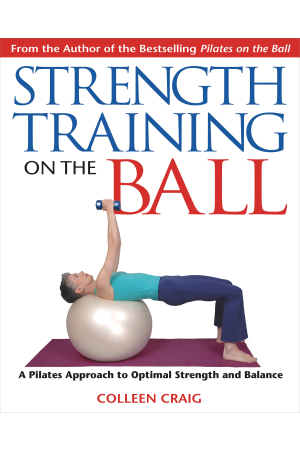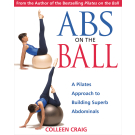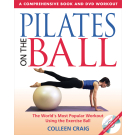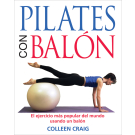Strength Training on the Ball
A Pilates Approach to Optimal Strength and Balance
- Pages: 272
- Book Size: 8 x 10
- ISBN-13: 9781594770111
- Imprint: Healing Arts Press
- On Sale Date: April 13, 2005
- Format: Paperback Book
- Illustrations: 140 b&w photographs
• From the bestselling author of Pilates on the Ball and Abs on the Ball
• Features specialized strength-training workouts for readers of all ages and fitness levels
• Chapters include check points to help readers set realistic goals and tips for physical educators, coaches, and Pilates teachers
In Strength Training on the Ball Colleen Craig shows readers of all fitness levels how to build strong bones, improve balance, and reduce body fat while toning and defining the body. Combining the unique functions of the exercise ball with the endurance- and flexibility-building benefits of strength training, Craig presents 75 ball exercises using weights, resistance bands, and the body's own resistance. Her exercise variations make strength training safe for beginners, children, teenagers, and seniors and challenging enough for the seasoned athlete.
Strength Training on the Ball is modeled after Craig's groundbreaking and bestselling works Pilates on the Ball and Abs on the Ball. It contains step-by-step photographs for each of the exercises, check points to help readers set realistic yet motivating goals, and teaching tips for physical educators, coaches, and Pilates teachers. The book concludes with three specialized strength workouts: a therapeutic workout for those recovering from injuries, a basic workout for absolute beginners, and a challenging workout for athletes and gym enthusiasts.
Ball as Bench
Because you are working on a mobile surface and moving the arms through a full range of motion, you will not be able to load up with heavy weights. Begin with 1- or 2-pound weights. Later you can increase the weight slightly if desired. Lying back on the ball will set you up for a fuller range of movement, more than you could get on a mat and more comfortably than on a bench. Your head, neck, and shoulders are totally supported on the ball but the low back is off the ball to work the buttocks. Keep the hips lifted and the abdominals working to protect the low back. The center of the kneecap should be tracking over the second toe, feet parallel and hip-distance apart.
Purpose Chest Press works the pectorals and triceps; the single-arm work requires the obliques and deep rotators of the spine to stabilize the rib cage. Flies work the deltoids and pectorals. Tricep Isolator works the triceps muscles of your upper arms. Pullovers work the pectorals, intercostals, serratus, and abdominals.
Watchpoints • Make sure your head and neck are totally supported by the ball and not hanging backward. • For Chest Press and Flies, keep your weights at heart level; don’t let them drift up to head level. • When extending the arms, don’t lock the elbow: keep the elbow slightly bent in the top position. • Keep the abdominals tight and the buttock muscles activated to keep the hips working against gravity. • Keep the shoulder blades in place. • If your low back begins to hurt, use the modification below.
starting position
Sit on your ball. Walk your feet out and let the ball roll under you until your head and neck are totally supported by the ball. Hips are up; abdominals are engaged.
movement 1: chest press
1. Begin with the weights resting on the side of your chest, just above the armpits. The palms face forward. Inhale to prepare. 2. Exhale to raise the arms up to shoulder level, keeping the shoulder blades on the ball. 3. Repeat eight to ten times. Then try the same exercise with palms facing inward.
movement 2: single-arm chest press
1. Place the weight in your left hand. Begin with the left hand resting on the side of your chest just above the armpit. The palms face forward. Place your right hand on your hip or raise it directly above your shoulder as a counterbalance. 2. On the exhalation raise your left arm, keeping your body steady on the ball. 3. Repeat eight to ten times. Then perform the same exercise on the other side.
movement 3: flies
1. Open your arms to the sides, keeping the elbows slightly bent. Hug the ball with the back of your upper arms. 2. Keeping your elbows slightly bent, exhale to squeeze your arms together in a large semicircle, as if hugging a thick tree. 3. Reverse the circular motion to return to bottom. Repeat eight to ten times.
On the Belly
Because these exercises are performed in extension on a mobile surface, the muscles across the back--the erectors and the postural muscles--work as much as the arm and shoulder muscles. Keep your back straight and your abdominals pulled in as you squeeze through the upper back, pulling the elbows up and back. Keep the chin tucked and maintain a gaze focused toward the mat to stabilize the head and neck. For an added challenge, place one hand on a soggy small ball directly below the shoulder, but take care that the shoulder of the hand on the small ball remains down and not up by your ear. Any of these exercises can also be performed on your knees.
Purpose Movement 1, single-arm row, works the latissimus and the muscles of the shoulder. Movement 2 targets the triceps and the back extensors. Breaststroke works the trapezius and back extensors. Reverse flies work the posterior deltoid.
Watchpoints • Engage the abdominals to protect the low back. • If your low back is straining, do the modification on the knees or avoid the exercise. • Keep the movement slow and controlled. • Keep extended through the spine; the neck is long but not hyperextended. • Keep your gaze on the mat.
starting position
Digging your toes into your sticky mat, place one hand on a soggy small ball or on the mat. Hold one or two small weights in one hand. Pull in the navel. Keep the spine long, the head aligned at the top of the spine. Your gaze is on the mat.
movement 1: single arm row
1. Inhale and exhale to pull your elbow upward, lifting the weights toward your ribcage. Keep your arms close to your body. 2. Return to the start position. Keep your back straight at all times, abdominals engaged. 3. Repeat eight to ten times on one side, then switch to the other side.
movement 2: triceps targetter
1. Place one hand on a soggy small ball or on the mat. Place 1- or 2-pound weights in one hand and bend the elbow back to the waist. Inhale. 2. Exhale to extend the arm. Inhale to bend the arm. Keep the upper arm stabilized in space as your elbow bends and stretches. Your gaze is on the mat. 3. Repeat eight to ten times, then switch arms and work the other side.
movement 3: breaststroke
1. Start with no weight or 1-pound weights just in front of the shoulder. Inhale. 2. Exhale to extend the arms straight forward, keeping shoulders down and away from the ears. The gaze is on the mat. 3. Inhale to sweep your arms all the way around and back to your thighs, lifting your upper body slightly. Your gaze remains on the mat. 4. Repeat five times, slow and smooth.
Introduction: Function Versus
Strength
Liuda’s Story
Recovering Function and Strength
Connecting the Dots: A Pilates Approach
Not a Recipe Book
1. The Ball and The Method
Aquilino’s Story
The Pilates Method: Over Ninety Years
Old and Growing Strong
Why Pilates-Based Ballwork?
Check-In: Getting Started
2. Breathing and Releasing
Maria’s Story: Freeing the Rib Cage
The Three-Dimensional Breath
Rest As You Go: An Italian Story
The Breathing Exercises
Ball Breathing • Chest Opener with
Arm Circles • Breathing and The
Hundred
Check-In: The Right Ball for You
3. Stability Before Strength
Dawn’s Story: Achieving “Moving
Stability”
“Big Engines” Versus “Control Engines”
Nervous-System Error
The Pre-Pilates Stabilizing Exercises
Navel-to-Spine • Tailbone Curls • Pelvic
Floor and Knee-Lift Stabilizing Exercise
• Heel Slides and Single-Leg Circles
• Scapula Isolation and Rib Cage
Stability • Half Roll-Downs with
Resistance Band
Check-In: The Work of Attention
4. Strength Training, Posture, and Balance
Arthur’s Story
Posture: Staying in Line with Gravity
Uncovering a New Neutral Spine
Strength Training and Balance
The Footwork
The Footwork Exercises • Squats
with and without Weights • Single-
Leg Footwork and Lunges
Check-In: Balance Tests and Postural
Assessment
5. The Abdominals: The Powerhouse
to Strength
Cindy’s Story: Activating the Elevator at
the Base of the Powerhouse
The Powerhouse: A Three-Dimensional
Cylinder
Crunches Versus Curls
The Key Powerhouse Builders
Pelvic-Floor Elevator • Knee-Lift
Stabilizing Exercise • Abdominal Curls
• The Roll-up • Single- and Double-Leg
Stretches • Oblique Twists • With the
Small Ball • Ab Curls on the Ball
• Abdominal Challenges • Side-Twist
Plank with Leg Lift
Check-In: Dieting Blues
6. Strength Training and Antiaging
The Long Slow Goodbye of Aging
The Antiaging Benefits of Strength
Training
Osteoporosis--The Silent Bone Saboteur
Light Versus Heavy Weights
The Pilates-Based Arm Work
Ball as Bench • On the Belly • Bicep
Curls/Wrist Curls • Side-Lying Arm
Work • Sitting on the Ball with
Weights
Check-In: Weight Training and Women
7. Strength Versus Flexibility
My Summer Yoga Class
Stressful Lives, Stressed Bodies
Functional Flexibility
Band and Ball Stretches
Single-Leg Stretch Series • Inner
Thigh Stretch • Hip Stretch • Spinal
Twist • Hip-Flexor Stretch • Kneeling
Hamstring Stretch with Ball • The
Tabletop and Quad Stretch
Check-In: How Are You Doing?
8. Rebuilding Strength
Sadie’s Story--Battling a Crippler
The Science of Back Pain
Extreme Sports and Weekend Warriors
The Resistance-Band Exercises
Sitting on the Ball: Upper Body
• On the Mat: Lower Body • Extensions
• Roll Downs with Pull
Check-In: Treating Your Low-Back Pain
Options and Home Care for Low-Back Pain
9. Recovering Strength and Playfulness
in Youth
One in Four: A Page from a Teen’s Diary
Out-of-Shape Kids
Balls in Schools
Hyperactive Kids and the Ball
Strength Exercises for Children and Teens
Sitting • Extensions and Airplane
• On Elbows • Side Star • Throw and
Catch • Ball Squat forTwo • Teaser for
Two • Balance Test
Check-In: Solutions for Inactive Families
10. Strength Training for Older Adults
A Tolstoyan Story
The Self-Fulfilling Prophecy of Aging
Older Adults and Exercise
Sitting and Pelvic Movements
• Resistance-Band Arm Work
• Bridges • Planks • Hamstring Curls
with Two Balls
Check-In: Posture Control and How to
Complement Your Strength Workout
Final Words
Workout 1: Restorative Strength
Training
Workout 2: Basic Strength Training
Workout 3: Intermediate Strength
Training
Resources
Ball and Video Ordering Information
Acknowledgments
Publishers Weekly, Apr. 11, 2005
"Combining the exercise ball with the flexibility of Pilates-based strength training is an unusual approach to exercise, but Strength Training on the Ball provides an optimal program for combining the two well-recognized exercise approaches, and offers many step-by-step instructions for routines which are realistic and easy."
The Midwest Book Review, Nov 2005
In Strength Training on the Ball, Colleen Craig shows readers of all fitness levels how to build strong bones, improve balance, and reduce fat while toning and defining the body. Combining the unique functions of the exercise ball with the endurance and flexibility benefits of Pilates-based strength training, Craig presents over 140 exercises using weights, balls, bands, and the body’s own resistance. She introduces innovative work using two balls for developing core stability, the hallmark of the Pilates approach and a key to building a strong body and functional movement patterns. Her exercise variations make strength training safe for beginners, children, teens, and older adults and challenging enough for the experienced athlete.
Strength Training on the Ball is modeled after Craig’s groundbreaking and bestselling works Pilates on the Ball and Abs on the Ball. Step-by-step instructions and photographs outline every exercise, and each chapter contains checkpoints to help readers set realistic yet motivating goals. Personal stories throughout the book illustrate how strength training can improve quality of life. The book concludes with three specialized strength-training workouts: a therapeutic workout for those recovering from injuries, a basic workout for beginners, and a challenging workout for athletes and gym enthusiasts.
COLLEEN CRAIG, author of the bestselling Pilates on the Ball and Abs on the Ball, is a certified Stott Pilates trainer and a writer. She lives in Toronto and teaches workshops worldwide.









